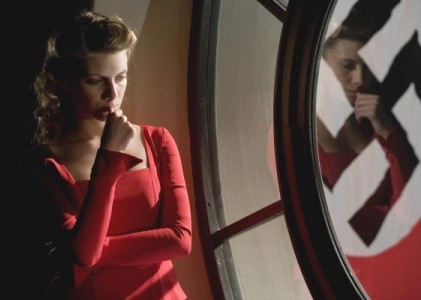Moments of 2009
We invited our regular contributors and colleagues, as well as some of our
favorite writers and artists, to select their moving-image moment or
event of 2009—anything from an entire movie or TV series to an
individual scene or shot, from a retrospective or exhibition to a viral
video or video game.
Gary Giddins, critic and author of Natural Selection
The Breaking Point, Michael Curtiz's great, reasonably faithful 1950 adaptation of Hemingway's To Have and Have Not, was televised in the '60s and '70s, but later got buried by legal issues involving the Hemingway estate. At the 2009 Telluride Film Festival, it was shown in a series of neglected classics curated by Alexander Payne. As often happens, a film I thought I knew well from TV and a bootlegged DVD became a deeper experience when projected on the big screen before a clearly moved audience. Superbly photographed by Ted McCord, the film departs from the novel on two Production Code issues: Harry Morgan (John Garfield) can't cheat on his wife or die. But Curtiz and scenarist Ranald MacDougall created a more devastating, purely visual, finish than that of the novel. The severely wounded Morgan is carried off his boat onto a dock crowded with onlookers, including the small son of his murdered partner (Juano Hernandez). The camera looks on as the crowd disperses, leaving only the confused black boy (played by Hernandez's real son, Juan), alone, lost, and uncared for. Everyone I spoke to was astonished at the extraordinary power of that image, which was hardly noticed in 1950.
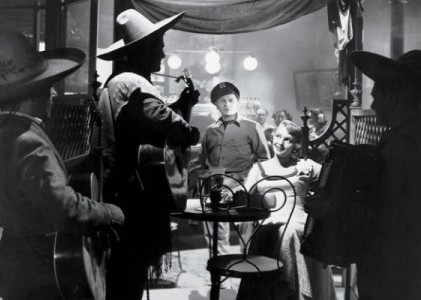
Joshua Clover, author of 1989: Bob Dylan Didn't Have This to Sing About
On the night of December 7, I watched a movie called The Potentiality of Storming Heaven. It's of the genre known as "riotporn," and captures images of the Greek insurrections in late 2008 into 2009, centered in the Athens neighborhood of Exarcheia, where Special Guards had murdered Alexander Grigoropoulos, an unarmed 15-year-old student. Greek anarchists and their comrades don't play. They are seen repeatedly charging police lines, sometimes in makeshift protective gear and armed with stones and sticks and rag-stuffed bottles of gasoline. The cops have more at their disposal, of course. I watched this in Wheeler Auditorium at UC Berkeley, capacity 760, which had been occupied by about 80 dissident students, workers, a couple faculty members. The cops kept coming in to tell us we had to go or we would be arrested. They would glance up at the huge screen and then offer their official "admonition." Nobody left. Eventually the movie ended—we watched it twice—and we started a dance party and when the cops came in for a last time somebody just turned up the music.
Thomas Doherty, professor of American Studies, Brandeis University
The most indelible image of 2009 was captured by an amateur: the jerky cell phone video of the beautiful young Iranian woman, Neda Agha-Soltan, shot dead on the streets of Tehran. She is on her back, her eyes are wide open, maybe already lifeless, her face streaked with blood, surrounded by anguished people who are as helpless as you are.
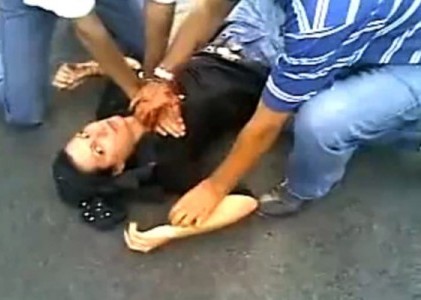
Laurence Kardish, senior film curator, Museum of Modern Art
I regret that Jacques Audiard's A Prophet has not yet opened in the U.S. but the film "moment" that sent the most pleasurable shivers through me was at Cannes this year. It came during the final shots of the film (which is, of course, in French and Arabic) when, out of the blue and in perfect synchrony with what went on before and with what will continue long after the film is over, a song originally written in the late 1920s in Germany and sung in English by Jimmie Dale Gilmore is heard over the last narrative movements. (I don't want to say anything more for fear of spoiling this marvelous finale.)
Florence Almozini, program director, BAMcinématek
I am awarding the Kubrickian Movie Moment of the year to Bronson by Nicolas Winding Refn. My scene takes place when Michael Petersen/Bronson is momentarily interned in a mental asylum—there is an eerie dance party, with the inmates awkwardly and poetically dancing around while the haunting Pet Shop Boys song "It's a Sin" blares in the background.
Annette Insdorf, director of undergraduate film studies, Columbia University
I experienced two cinematic high points in 2009: the beautifully "lived in" performance of Jeff Bridges that anchors Crazy Heart and 1928's L'argent. It was breathtaking to see L'argent at the Telluride Film Festival with live musical accompaniment: Marcel L'Herbier's silent French drama is reminiscent of Abel Gance's heightened visual lyricism in Napoleon. And from the moment Bridges emerges from his van in the opening of Crazy Heart—so seedy, grizzly, and bedraggled that I could almost smell him—I was hooked on this actor's pitch-perfect incarnation.
Sukhdev Sandhu, chief film critic, The Daily Telegraph
Agnès Varda's The Beaches of Agnès, Chris Marker's The Case of the Grinning Cat, Linda Hattendorf's The Cats of Mirikitani: This is a golden age for those of us enamored by moggies. The most charming ones, as surely everyone knows by now, are to be found on the Web. If 2008 belonged to Maru, 2009 was the year of the quite delightful "Surprised Kitty."
Melissa Anderson, critic
My favorite films of 2009 perfectly combined sound and vision: Mati Diop and Grégoire Colin burning with desire to the Commodores' "Night Shift" in 35 Shots of Rum; María Onetto trying to regain her composure while Middle of the Road's "Soley Soley" plays on the car radio in The Headless Woman. But the most memorable music is every syllable of Terence Davies's narration in Of Time and the City. "Between loving and hating, the real journey starts," Davies reminds us in this profoundly felt personal essay, his orotund delivery an unforgettable mix of spleen, melancholy, and longing.
Chris Fujiwara, critic and author of Jerry Lewis
Of the films I saw for the first time in 2009, the ones that still seem most irreducible and new are Pere Portabella's avant-garde features Cuadecuc-Vampir (1970) and Umbracle (1972). Writing on the Portabella retrospective at the Jeonju International Film Festival for Undercurrent, I said that Christopher Lee gave in Umbracle "one of the greatest and most complete performances in cinema." Obviously that was hyperbole, but I remember the actor, and Portabella's way of filming him, with much pleasure. Made under a military dictatorship, these two films are totally free.
Leah Churner, archivist and curator
In late 2008 and early 2009, network television stations ran hours of public service announcements about the demise of analog broadcasting. Designed to allay confusion about government vouchers and digital converter boxes, the early ads actually spread misinformation—at the end of January, Congress passed the Digital Television Delay Act, postponing the transition date from February 17 to June 12. For the most part, however, these PSAs gracefully executed the dual task of comforting the panic-prone and rousing cynics to action. Dozens of these ads still live on YouTube; here are two classics. First, the Lawrence Welk estate extends a hand across the digital divide in a euphemistic, "Hello-I'm-So-And-So" address from an empty auditorium. Second, NHL stars perform an ersatz blooper reel bathed in tanning-bed light.
RIP analog television!
David Hudson, daily blogger, The Auteurs
The materiality of paper cash throughout Christian Petzold's Jerichow.
Andréa Picard, programmer, TIFF Cinematheque
It's a triple tie for me: 1) Manoel de Oliveira's Tetralogy of Frustrated Love shown at TIFF Cinematheque: An astonishing tetrapack that deserves to be seen by cinephiles the world over. 2) Jean-Pierre Gorin's lecture on Sans Soleil at TIFF Cinematheque: Pure pesky, intellectual fun. 3) Merce Cunningham performs Stillness (in three movements) by Tacita Dean, seen at the Musée d'art contemporain in Montreal and at Le Centquatre, Paris: Sheer beauty, calm, grace, and transcendence in 6-x-16mm.
Kevin B. Lee, critic and filmmaker
Grizzly Bear's "Two Weeks" inspired two of the best music videos of 2009. The official video is by Patrick Daughters, arguably the most sought-after video director working today. The other is a fan video created by Gabe Askew over four months' worth of nights and weekends. Daughters finds a visual motif correlating to the music's cherubic creepiness; Askew uses the lyrics to launch into romantic reverie. Daughters explores face; Askew space. That they are of a comparable level of achievement (regardless of which you prefer) attests to the democratized nature of online visual media.
Anne Nelson, author of Red Orchestra
My moving-image moment involved a visit to the DEFA Film Library at the University of Massachusetts, Amherst. When I researched my book, Red Orchestra, I came across their collection of forgotten East German classics in the New York Public Library and tracked the films back to their source. My favorite discovery this year was The Kaiser's Lackey (Der Untertan, 1951), a blistering satire of the Prussian bourgeoisie who paved the way to Nazism, based on a Heinrich Mann novel and directed by the accomplished Wolfgang Staudte (Murderers Among Us).
Martin Rubin, associate director of programming, Gene Siskel Film Center
The moving-image high point of 2009 for me was watching—wide-eyed and open-mouthed—the gorgeous, glowing, blacks-so-black UCLA Film & Television Archive print of Letter From an Unknown Woman during an Ophüls series at the Gene Siskel Film Center in June. It's not as if I hadn't seen this devastatingly great film 10 or 20 times before, but I felt that I had never really seen it before. This screening was a vivid demonstration of (1) why showing movies in 35mm is so important, and (2) how much difference a great print can make in our experience and estimation of a film. So let's take a cup o' kindness for all the hardworking archivists, enlightened distributors, and (ahem!) dedicated programmers who are striving to keep this costly, supposedly doomed, and truly irreplaceable format alive.

R. Emmet Sweeney, critic
Mark Neveldine and Brian Taylor unleashed wild shotgun blasts of ideas in their two 2009 releases, Crank: High Voltage and Gamer. Abandoning the relative unity of the original Crank, these two glorious concatenations of gonzo cinema alternated between the ridiculous and sublime with every camera move. The scene that encapsulated their approach is Michael C. Hall's meat-puppet pantomime to the Sammy Davis Jr. version of "I've Got You Under My Skin" in Gamer. Hall's tech tycoon uses his nano-machine mind-control to lead some lucky prisoners in an elegant soft-shoe routine that seamlessly shifts into a Gerard Butler beatdown. For Neveldine and Taylor there is no difference between fighting and dancing, only the pure cinema of bodies in motion.
David Schwartz, chief curator, Museum of the Moving Image
While waiting patiently for the Museum of the Moving Image to open its new theaters (coming in 2010!), many fine hours were spent at Film Forum (thanks, Bruce Goldstein, programmer extraordinaire). Standouts were two double features, one intentional, one serendipitous: The former was Frank Borzage's sublime New York Depression-era romance, A Man's Castle, in which a rugged, virile, pre-Code and pre-tamed Spencer Tracy courts a young Loretta Young (they skinny-dip in the East River, next to their shantytown home) and Me and My Gal, the snappy, wisecrack-filled Raoul Walsh dazzler for which Manny Farber was born to appreciate. A somewhat accidental double feature paired Chantal Akerman's Jeanne Dielman and Nicholas Ray's Bigger Than Life, both films containing barely repressed rage, and both featuring bold, stylized color. Ray's film showed Akerman's to be more wonderfully stylized than it first appeared, and Akerman's showed Ray's to be more realistic. Finally, attention must be paid to some great moments in 3D: Henry Selick's Coraline, the underrated Monsters vs. Aliens, and most of all, James Cameron's breathtaking Avatar. For the first time, I really did feel like I had entered the world behind the screen, à la Keaton in Sherlock Jr. The real master of 3D (and 2D), Ken Jacobs, will have his turn at the Museum in 2010.
Scott Foundas, associate program director, Film Society of Lincoln Center
The final shot of James Cameron's Avatar, which mirrors one of the earliest: a tight close-up on the face of the ex-Marine Jake Sully, opening his eyes as he is "reborn" in his genetically engineered avatar body. It is a single image that seems to encapsulate so much of the push and pull between the organic and the synthetic, man and machine, art and technology, that defined not only the past year in cinema but the entire past decade. Along with the Romanian beat cop who becomes a kind of cine-voyeur as he tails his suspect in Corenliu Porumboiu's Police, Adjective, Jake Sully was the year's other great example of the dramatis personae as audience avatar—a protagonist who, like the viewer himself, slips on an alternate skin and travels through an alternate reality, until the lights come up and he returns to the real world from the waking dream. But where Porumboiu's cop moves through a fundamentally analog actualité, Jake Sully descends into the world's ultimate MPRPG, an imaginarium so vast that Peter Jackson's heaven looks like a penny-ante sideshow by comparison. As he toggles between bodies (human and Na'vi) and worlds (one "advanced" and dying, the other "primitive" and unspoiled), he is very much today's modern media consumer, who makes increasingly little distinction between books and movies and video games, between the singular viewing experience of iPhones and laptops and the shared experience of big-screen cinema, between art that recreates reality and that which redefines it. When Jake Sully opens his eyes, what does he see?
![]()
Richard Porton, editor, Cineaste
Although I didn't make it to the Viennale, Vienna's film festival, in 2009, the next best thing was the opportunity to peruse The Unquiet American, the catalog of a retrospective, curated by Jonathan Rosenbaum, devoted to American comic films with a critical or satirical edge. Rosenbaum's lively entries bypass rigid generic boundaries to create an intriguing comic landscape where Billy Wilder and Jerry Lewis rub shoulders with avant-gardists such as Jack Smith and Manuel De Landa. I was particularly pleased to note the inclusion of one of the best dark comedies of the 1960s, George Axelrod's Lord Love a Duck (1966), and the sagacious decision to highlight Albert Brooks's work and exclude Woody Allen's. With some luck, a North American repertory cinema or cinematheque will reprise this series on our own shores.
Geoff Andrew, head of film programming, BFI Southbank
Perhaps the moving-image moment of the year for me was the scene in Michael Haneke's The White Ribbon where the teacher and his fiancée-to-be are riding in the carriage in the country, and she asks him—for reasons of modesty—to turn around and not go to the picnic place he is taking her to. After reassuring her of his good intentions, he agrees to turn around anyway, and in gratitude she kisses him lightly on the cheek. I chose this single-shot scene for a number of reasons. It is written, filmed, and played with marvelous delicacy and subtlety, and its concision and simplicity serve the dynamics of the overall drama of the film perfectly. It is also a wonderfully tender scene, and that in itself should help to lay to rest the misconception that Haneke is some sort of cold, inhumane filmmaker lacking in compassion for his characters (one might as well say the same thing of Bergman or Bresson if one insists on having the director's sympathies flagged up all over the place). And it is a salutary reminder than even in the most rigid, feudal, or illiberal societies, human goodness and kindess and love still exist.
Michael Koresky, writer and editor, The Criterion Collection and Reverse Shot
Does it make me a hopeless, hermetic cinephile to say that I got the most cinematic charge this year from the climax of Inglourious Basterds? Watching the photogenic Mélanie Laurent's phosphorous giant face laughing maniacally while suspended in mid-air in a burning theater, projected onto billowing smoke where there was once a movie screen, I felt the primal charge missing from all other moviegoing experiences in 2009, even within more sensitive, perhaps better films. Not only did Tarantino's image give the film its clear raison d'être (say what you will about Tarantino's idyllic-catastrophic cinema-saves-all ending, there's never been a better expression of what this guy is doing with celluloid), it also gave its surprise protagonist her life back. Cinema as resurrection? I'll buy that. But it's also clearly, intentionally a resurrection predicated on a reversal of history so impossible, fanciful, and outrageous that its victory can't help but be pyrrhic. Its power is shattering.

Ron Rosenbaum, columnist for Slate and author of The Shakespeare Wars
I have to say seeing Christian McKay's performance as Orson Welles in Richard Linklater's Me and Orson Welles (which inspired me to write an essay in Slate on the ambiguities of genius) was most memorable to me. Prior to that time the supreme Welles moment for me was the rejection scene—no, his entire performance as Falstaff—in his mangled but inexpressibly beautiful Chimes at Midnight
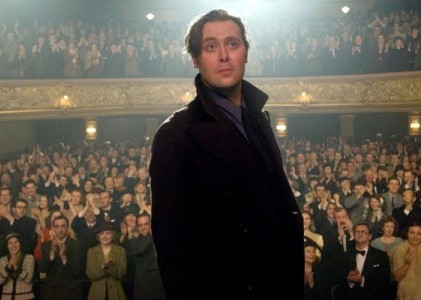
James Naremore, author of On Kubrick
Of the pictures I've seen so far, the one that stays in my mind most forcefully is Corneliu Porumboiu's Police, Adjective.
One could argue that the hallmark of the contemporary art cinema,
especially in Romania, is the long take and dead time, but this film
uses that anti-Hollywood technique in especially brilliant ways,
usually in the service of a kind of "humor gris." An entire essay could
be written about the different sorts of dead time it depicts and the
different shades of emotion they involve. I haven't seen a movie that
employs real duration so effectively since Jeanne Dielman,
which is of course very different in tone. I also think that
Porumboiu's lead actor, Dragos Bucur, is almost as important to this
movie as Delphine Seyrig was to Akerman.
Antonio Campos, director of Afterschool
In trying to decide which "moment" to highlight for 2009, I began thinking of the plethora of viral videos I watched over the year. My brain has gone from some profound moments (Obama's inauguration) to the profane (Rep. Joe Wilson screaming "You lie!") to the tragic (Iranian protester Neda shot and killed on camera) to the inane (surprised kitty) to what I guess you could call the "trainwreck" (Balloon Boy saying "We did it for the show.")
But I've decided to highlight a film that has stuck with me since I saw it at the New York Film Festival. Police, Adjective, by the Romanian director Corneliu Porumboiu (12:08 East of Bucharest), could be called a crime procedural, much like He Walked by Night or The French Connection, except it focuses on a small crime and there are no chases or gunshots. The focus is on the waiting and observing, but it is equally about the meaning, or lack of meaning, of words and language.
I've chosen one of the domestic scenes in the film. It's a long one, but I believe if you give it a chance you'll find it funny and enlightening. I admire directors who can create tension out of nothing, but I have equal admiration and respect for those who are able to draw humor out of the painfully mundane. In this scene, Porumboiu does that brilliantly. When most people have become so accustomed to everything happening in a nice viral size of 30 seconds to a minute, good cinema that takes its time is necessary so we don't all end up developing ADD.
Michael Joshua Rowin, critic
Only the Coen brothers would evoke a suburban Jewish man's spiritual crisis by blending Talmudic sagacity with psychedelic rock, and the year's most thrilling movie moment came from a virtuoso montage sequence from A Serious Man in which Michael Stuhlbarg's schlemazel protagonist listens to a rabbi's epic moral tale about a mysterious orthodontic miracle, scored to Jimi Hendrix's blistering acid rock classic "Machine Gun." Begging for a direct explanation of the story, Stuhlbarg receives the punchline in the form of classic Jewish folk wisdom: "Look. The teeth, we don't know. A sign from Hashem? Don't know. Helping others . . . couldn't hurt."
Saul Austerlitz, author of Money for Nothing
The end of A Serious Man is itself a proof of the very uncertainty it reflects on: just as its shaggy-dog story has been neatly resolved, the reunited parents shepping naches over their son the bar mitzvah boy, a tornado approaches. The huge gray cloud envelops the screen, and Larry (Michael Stuhlbarg), seemingly spared the worst in his trials, is symbolically condemned to death, the victim of God's terrible absence. The symbolism is rich, complex, and infinitely mysterious: Just what is looming?
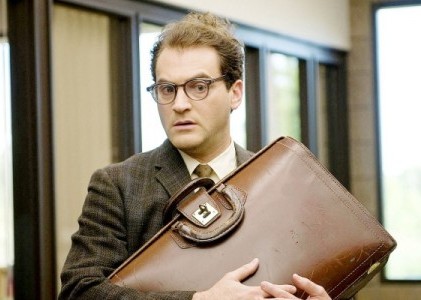
Dennis Lim, editor, Moving Image Source
Jim Jarmusch made his definitive movie, a paragon of insinuating mystery and effortless cool, only to earn a dismissive shrug (or worse) from most critics. The Limits of Control is nothing if not a movie of moments: the slow-motion approach of Tilda Swinton’s cinephilic femme fatale, Isaach de Bankolé’s emergence in Bill Murray’s bunker via a single cut (he used his imagination), the jolting final camera movement that literalizes the title. But my favorite passage—an emblematic one for a movie that de Bankolé’s supremely poised hero glides through with lips sealed and senses sharpened—follows the arrival of the Lone Man in a spare Seville apartment: he looks out the window, sits on his bed, stretches out as the light changes and the alien sounds of a new neighborhood wash over him. These are moments we almost never see in movies today, about nothing more or less than the act of being fully present.
David Sterritt, film critic, Tikkun
Paranormal Activity has become the most profitable movie ever, turning a budget in the low five figures into more than $100 million in domestic grosses alone. So much for my theory that the picture's clunky title and rocky road to distribution (the savants at Sundance rejected it; studios wanted to scrap it and remake it) would drag it to hell. What fascinates me is its excellence in the super-challenging genre of minimalist horror. Its unlikely provenance (first-time director, neophyte actors) and video-diary form strongly recall The Blair Witch Project of a decade ago, but that movie was grounded in gimmicks, whereas Paranormal Activity is bona-fide scary, sustaining a mood of threat and menace with frightening success. Arriving in the same year as the wicked Orphan and the rollicking Drag Me to Hell, it gives me hope that movie horror, suffocated for so long by clichés and special effects, may be having a spooky renaissance at last. Let chaos reign!
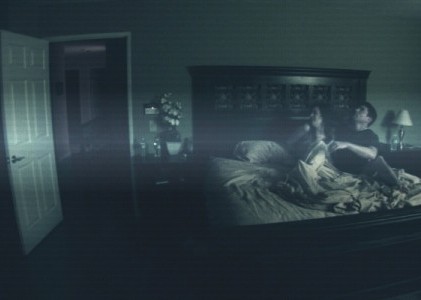
Mark Peranson, editor of Cinema Scope
May 6, Barcelona at Chelsea, Champions League Semifinal. I arrive in Madrid with Albert Serra for a screening of my film Waiting for Sancho at Documenta Madrid, and hurriedly find a small bar near Puerta del Sol to watch the game with locals and surreptitiously record them, assuming the heartless Madrilenos would be rooting for Chelsea to massacre their Catalan rivals from the south. I'm pulling for Barcelona, not just because Chelsea is undeniably evil, but out of respect for Sancho, who has a large Barca crest tattooed on his left forearm. Throughout the horribly refereed match, which led to Barcelona playing one man down for most of the second half, the atmosphere is fully electric, and the bar is surprisingly of one for their southern cousins. Down a goal and three minutes into injury time, Lionel Messi sets up midfielder (and Spanish national, I should add) Andres Iniesta, who volleys a magical shot from 35 yards—the only shot on goal for Barcelona in the entire 93 minutes. As it blasts into the corner of the net, all hell breaks loose on the field and in the bar. Soda-pop-sized bottles of Mahou beer fly through the air, and I find myself surrounded by Spaniards who are prostrating themselves toward a 20-inch TV high above, chanting "I-nieeeestaaaa... Innniiiesssssta" as their hero poses shirtless for the camera. Barcelona advances on away goals and goes on to win the Champions League in a dull match against Manchester United. It's Spain's year. Meeting Albert for dinner later that night, I ask if he saw the ending to the game. "I heard loud cheering, I thought that Barcelona lost." It was then I realized that I had fully understood the Catalan mindset.
Jonathan Rosenbaum, critic and author of Essential Cinema
The first eye-popping masterpiece that I saw in 2009 in some ways remains the best, although, to the best of my knowledge, it has yet to show at any film festival, thus offering a cinching reproach to those colleagues of mine who believe they can offer conclusive judgments on the overall quality of world cinema over the past decade—or any other period, for that matter. (In an effort to rectify this absurd impasse, I've selected it as a Critic's Choice for the upcoming Trumsø International Film Festival, January 18-24, near the northernmost reaches of Norway.) Peter von Bagh's Helsinki, Ikuisesti (Helsinki, Forever) is a lovely city symphony of found footage that is also a history of Helsinki (and incidentally, Finland, Finnish cinema, and Finnish pop music) recounted with film clips and paintings by three voices (one of them von Bagh's), each one periodically reciting different segments in the film's poetic and essayistic discourse.
The continuity is more often geographical than chronological, although there's also a lot of leaping about spatially as well as temporally. The film is an unalloyed pleasure to watch and listen to, but professional packagers hoping to fix a convenient generic label to this flood of delights might be flummoxed. At separate stages we're introduced to the best-ever Finnish camera movement and the best Finnish musical, invited to browse diverse neighborhoods and eras (and to ponder contrasts in populations and divorce rates), and finally forced to admit that a surprising amount of very striking and beautiful film footage has emerged from this country and city.
Peter von Bagh—prolific film critic, film historian, and professor, onetime director of the Finnish Film Archive and current artistic director of two unique film festivals, the Midnight Sun Film Festival (held in Sodankylä, above the Arctic Circle, during what amounts to one very long day in the summer) and the magnificent Il Cinema Ritrovato (held in Bologna)—is the man who convinced me to purchase my first multiregional VCR in the early '80s. So he has a lot to answer for, including, for instance, my DVD column in Cinema Scope. Thanks to his unwarranted modesty about his film, I don't believe he's gone public with the responses he's already received from Chris Marker ("If I read in [Walter Ruttmann's] Berlin the social commitment and the aesthetic maestria, I don't feel the personal acquaintance with the city, its history, its ghosts, that I found in yours") and Jean-Pierre Gorin ("Paean to these cities that you inhabit both, the one called Helsinki and the other called Cinema"), but he certainly should.
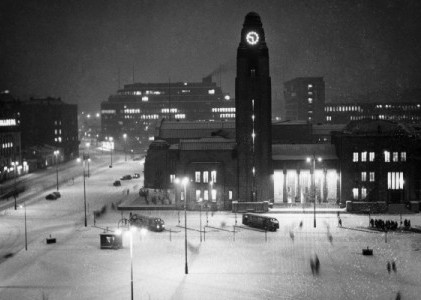
Josh Siegel, associate film curator, Museum of Modern Art
Pace Mark Sanford, John Edwards, Chris Dodd, John Ensign, Sarah Palin, Desirée Rogers, William Jefferson, Charlie Rangel, Sheila Dixon, Mike Easley, Sam Adams, Gary Becker, Michele Bachmann, and Mike Duvall: In a year that had its share of riveting, bewildering, salacious, bilious, and enraging press conferences—why should this year be different from any other?—former Illinois governor Rod Blagojevich elevated a timeless act of contrition and defiance to an art form. Not since Nixon's Checkers speech or the courtroom defense of Clay Davis, the Maryland state senator in The Wire, have we been treated to such honey-tongued cynicism and enjoyed it so much.
Here, then, is a curated selection of some of Blago's finest moments, including his eloquent recitations of Kipling and Tennyson and his karaoke act with Fabio: 2006 gubernatorial campaign ad; April 23, 2008; December 8, 2008 (1); December 8, 2008 (2); December 19, 2008; January 9, 2009; January 29, 2009; February 3, 2009; February 12, 2009; April 14, 2009; September 22, 2009. These three clips show the uncanny rhetorical parallels between the former governor and Clay Davis. Sheeeeeeeeit.
Bérénice Reynaud, film and video programmer, Redcat
My scene is from Du Haibin's 1428 (China, 2009). A figure haunts the earthquake-devastated area of Beichuan: a young man in weird-looking, unkempt clothes and shaggy hair, seen roaming through the destroyed streets or sleeping in the ruins. His face is pasty, dirty, and expressionless, almost as if he were wearing stage makeup; he seems to be ubiquitous, floating more than walking. His surreal appearance marks a beat, a punctuation; there is something theatrical about it—to the point that one can wonder if Du Haibin had not mixed performance art and documentary.
Then reality and surrealism coalesce by exploring the depth of a field of rubble: in the foreground, an old man carries a bowl of rice; in the background, his son appears: it's the mysterious madman. In a post-earthquake situation, the world does not make sense anymore, the gods are irresponsive or unconscious. Du orchestrates the presence of the madman of Beichuan as a ghost for all the missing sons—but also as a lost son himself, with a name, a history, a flimsy claim on the ruined land—and finally as a metaphor for the absence of a master gaze: his vacant eyes open onto nothing...
Michael Atkinson, critic
I might like the past a little more than the present, but I'm naive about neither, and so it comes as no particular surprise for me to realize that as my world becomes more and more overheaped by media images coming at me from even the walls bordering baseball diamonds and cell phones and elevator ad-TVs and train-station screens and moving mall posters and PIP ads playing during TV shows, ad infinitum, that as this cataract of this bullshit grows, I become less interested in it. The more two-dimensional rectangular "content" streams in my vicinity, the more I crave intercourse of other stripes, be it social, sexual, literary, even manual.
But that's not "movies," of course, it's mostly advertising, even when it doesn't seem to be, and if my universe is getting defiantly smaller, not larger, with each passing bombarded media hyper-minute, then it is still almost infinitely large. 2009 was when I saw my first silent-Soviet pulp serial (Miss Mend), my first Hiroshi Shimizu, my first Murnau comedy (The Finances of the Grand Duke), my first Japanese neo-Tarkovsky sci-fi (The Clone Returns Home), my second Lettrist feature (Marc'O's Closed Vision), my first sampling of Santiago Alvarez, and so on. The best new films—Inglourious Basterds, The Headless Woman, I'm Gonna Explode, Hunger, The Baader Meinhof Complex, Up, The Sun—were all about the past, Godardian or otherwise. Maybe all the present had to offer was James Cameron and Twilight and more of the same old same old, by which I mean more of nothing nearly old enough, but more of the fairly recent, rechewed into a fluorescent mash and sold to us in our sleep as the all-important now.
So who's surprised: my year's moment was in a café, where Anna Karina was lookin' to get out, Jean-Pierre Leaud did some of his time in Iconville, and Marianne Faithfull, out of nowhere, sat in the corner and crooned "As Tears Go By" while the world stood stock still and held its breath. It was 1966 for them, in Godard's Made in U.S.A., but 2009 for us. This is what movies do: make the present irrelevant.
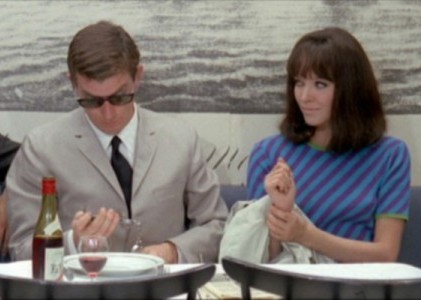
Leo Goldsmith, critic and editor, Not Coming to a Theater Near You
The alternative film programming at Brooklyn's Light Industry is hands down the best in New York, and among its many revelatory events this year were its two performances by local projection artist Bruce McClure. Utilizing multiple 16mm projectors, lighting gels, and aperture masks, McClure's work is live paracinematic performance art that combines stroboscopic effects (mainly from black-and-white leader, often thrown wildly out of focus) with the massive drone of the mag track run through a half-dozen guitar pedals. First in February, at Light Industry's main location in Sunset Park, and then in June, in a specially curated program for X-Initiative, McClure blew minds and eardrums with his audio-visual alchemy, exploring and exploding the cinematic frame as well as the aural space of the venues. (I missed his performance at the New York Film Festival, closing the Views From the Avant-Garde sidebar with what was undoubtedly a pretty heavy experience in the Walter Reade Theater.) A number of like-minded live-cinema performers have presented excellent work at Light Industry in recent months—including Sandra Gibson and Luis Recoder, and London's Emma Hart and Benedict Drew—but McClure's unapologetically psychedelic work has stuck with me the most, as it not only interrogates and reveals the cinematic apparatus, but also envelops and seduces one with it.
Ed Park, author of Personal Days
Who sent this to you? A clip from Inside Edition. It's like a bad dream that scans as ridiculous, laughable, when you piece it together over breakfast. A "beautiful cheerleader" named Desiree Jennings can no longer walk forward without flailing and doubling over. You gaze at the spectacle with pity and incredulity, unable to prevent your brain from flashing on the resemblance to John Cleese's more ornate silly walks. Then you learn that Desiree can walk backward without a hitch. Wait—what? Sorry, this clip is only two minutes long so before you can fully absorb that quirk, and the sinister mention of a flu shot, she starts talking and out comes a Muppet voice. "It started with me not being able to eat without passing out," she says. The Inside Edition correspondent, Les Trent, translates: "You couldn't eat without passing out." She confirms this with a grim headshake. Les Trent says he visited Desiree and her fiancée at their home in...Aspirin, Virginia? Google that later, because now you see her rounding a staircase backward. Cut to: exterior. "And here's the unusual part about the disorder," says Les. "Take a look at this." It's Desiree from a distance of 20 yards or so, booking it down the sidewalk. "Desiree can run just fine—it's only when she stops, you see that's where the spasms starts." She's made it all the way to Les and instantly crouches, violently hugging the air. "Now you can walk backwards, though, and it'll make it better, right?" he asks. Desiree moves backward, pants: "Yeah."
But there's more. Now both Les and Desiree are running pell-mell toward the camera, like two kids breaking out of school. "And now you can talk!" exults Les. "Yeah, it's weird, it fixes as soon as I start running." "You sound, you sound...!" Not like Kermit. "I know, it's great, isn't it!" "It's amazing!" "HHHH-hhh-hhh..." She collapses, skitters backward. "Whoops!" says Les.
You grasp again that a flu shot is being blamed, that doctors have diagnosed the one-in-a-million disease dystonia, that there is no known cure. Nor is there a cure for watching this amazing piece of performance art, in which mysterious levels of complicity generate mounting absurdities, all somehow in the name of the anti-vaccination movement. (Many of the uploads on YouTube feature an edit on Trent's narration, eliding the "n't": "Doctors say what happened to Desiree shouldn’t discourage people from getting flu shots.") Later episodes—what else to call them?—of the Desiree saga show her cured, able to speak normally....except when talking about her phantom ailment.
Nicolas Rapold, critic
The Auto-Tuned detournements by the Gregory Brothers started with the 2008 debates, but their fullest realization came with the quartet's absurd 2009 pastiche-medleys in which they insert themselves into news-show and Congress-floor footage. A full-fledged band in the analog world, Michael, Evan, Andrew, and Sarah (a Gregory by marriage) make videos that are in another league from typical YouTube pipsqueak takeovers. The reasons are several: wizardly cutting and pasting, catchy pop musicianship, good and unpredictable comic writing and timing, terrible wigs, and rudimentary rules of short-attention-span editing (e.g., changing a little something visually in a scene with every new cut back to it). Mildly diverting performers and single-idea techno riffs are a dime a dozen in viral videos but the Gregory Brothers create bits that get more impressive the closer you look at the stitching (which apparently involves the Auto-Tune plug-in from Antares and the Melodyne plug-in from Celemony, together with Logic audio-editing software). All of which makes something hilarious out of the tried-and-true sport of "reality checks" on political and media-show idiocy.
Jason Eppink, assistant curator of digital media, Museum of the Moving Image
I adore ThruYOU,
Kutiman's extraordinary seven-track "album" constructed solely of found
YouTube clips. Moving, haunting, and expertly constructed, it's the
Internet generation's answer to Christian Marclay's 2002 "Video
Quartet." And Auto-Tune the News,
the Gregory Brothers' toe-tapping reappropriation of the absurd
television "news" product was a monthly dose of lovely musical
subversion, until the group was co-opted by Sony.
But most appropriate for 2009, the year online video criticism came into its own, is Mike Stoklasa's
Star Wars: The Phantom Menace Review, a 70-minute takedown of George
Lucas's epic decade-old disaster. Stoklasa—in character as a
sociopathic, pizza roll-popping sex criminal—methodically picks apart
the film's cardboard characters, innumerable plot holes, and general
lack of narrative cohesion. Not only is the Review a fine work of pop
criticism, it's a vast improvement on the source material and a
milestone for an emerging online genre.
Chris Wisniewski, director of education, Museum of the Moving Image
In "Guy Walks Into an Advertising Agency," the sixth—and best—episode of Mad Men's uneven third season, the director and chairman of the British company that owns Sterling Cooper pay a surprise visit to the firm. With them they bring (the titular) Guy McKendrick, an impressive young executive who, unbeknownst to Mad Men’s central characters, is poised to become the COO of the American firm. Unfortunately, Guy doesn’t walk out of this advertising agency. When an office party gets out of hand, clueless secretary Lois (Crista Flanagan) takes a spin on a riding lawnmower, right over Guy’s foot. "One day you’re on top of the world, and the next some secretary is running you over with a lawnmower," sighs office manager Joan (Christina Hendricks), in her blood-splattered dress (foreshadowing Jackie Kennedy). This out-of-left-field moment encapsulates Mad Men at its best: it upends our expectations while portending the inevitable, violent change that would, by season’s end, turn its pristine pre-November 1963 world on its head.
Joshua Land, critic
My favorite performance of the year was María Onetto's mysterious turn in Lucrecia Martel's The Headless Woman.
Upon first seeing it, I was convinced her character had suffered some
sort of head injury in the film's pivotal automobile accident, but now
it seems more like a case of the Unbearable Lightness of Being. Not
only is Onetto almost totally passive throughout the film, she barely
reacts to the stimuli around her, often to the point of muteness. All
of us in the world's privileged classes—whether the Argentinean
bourgeoisie or the global community of aesthetes who seem to have been
the only audience for Martel's remarkable film—spent this
data-saturated decade getting closer to the rest of the world, often
against our will. Confronted with the horrors of poverty, war, genocide, and our own role in enabling them, the logical response is simply to shut down. Especially in a world filled with so many things we’d feel better off just not knowing. ![]()
LATEST ARTICLES
-20140814-173707-thumb3.jpg)
Fighting Words
by Imogen Sara Smith
posted August 12, 2014

Fighting Words, Part 2
by Imogen Sara Smith
posted August 20, 2014

On the Margins: The Fil…
by Andrew Chan
posted August 12, 2014

Robin Williams: A Sense…
by David Schwartz
posted August 12, 2014
 Moments of 2009
Moments of 2009
KEYWORDS
Hollywood | television | Avatar | Crazy Heart | Me and Orson Welles | A Serious Man | music video | independent cinema | Of Time and the City | Police | Adjective | Chantal Akerman | internet | Mad MenRELATED ARTICLE
Moments of 2011, Part 2 by Various WritersMoments of 2011, Part 1 by Various Writers
Moments of 2012, Part 1 by Various Writers
More: Article Archive

